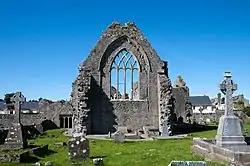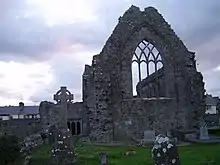Athenry Abbey
The Priory Church of Saint Peter and Saint Paul, Athenry, also called Athenry Priory, is a medieval Dominican priory and National Monument located in Athenry, Ireland.[1][2][3][4]
Prióireacht Peadar agus Pól, Baile Átha an Rí | |
 East window | |
 Location within Ireland | |
| Monastery information | |
|---|---|
| Other names | Ath-na-riogh; Ath-na-rig; Anry |
| Order | Dominican Order |
| Established | 1241 |
| Disestablished | 1574; 1698 |
| Diocese | Tuam |
| People | |
| Founder(s) | Meyler de Bermingham |
| Architecture | |
| Status | ruined |
| Style | Late Gothic |
| Site | |
| Location | Abbey Row, Athenry, County Galway |
| Coordinates | 53.298236°N 8.744544°W |
| Public access | yes |
| Official name | Athenry Abbey |
| Reference no. | 164 |
Location
Athenry Abbey is located in the eastern part of Athenry, east of the Clarinbridge River.[5][6]
History

Meyler de Bermingham was the founder in 1241.[7] Other local notables funded it: Feidlim Ua Conchobair, King of Connacht built the refectory; Owen Ó hEidhin (King of Uí Fiachrach Aidhne) built the dormitory and Conchobar Ó Cellaigh of Uí Maine the chapter house. The priory initially stood on the edge of the town walls, but was later enveloped by them.
A provincial chapter was held at Athenry in 1242. Flann Mac Flainn, Archbishop of Tuam, built a house for scholars in the 1250s. Founder Meyler was buried in the priory in 1252. His son William de Bermingham was Archbishop of Tuam; he had a dispute with the monastery in 1297 but was buried there in 1312.
The refectory (now destroyed) was built around 1265, with the chapel completed before 1340.
In 1324, William Liath de Burgh left money to enlarge the church and priory, a task completed by 1345. Joanna de Ruffur died in 1408 and left money to construct a new east window and windows in the choir.
Athenry Priory was burned in 1423; indulgences were granted by Pope Martin V and Pope Eugene IV to those who contributed to its repair. 1451, the friars built a chapel on land north of the river at Carrowardahrah, granted by Ulick Ruadh Burke.
The monastery was dissolved in 1574.
Athenry Abbey was burned during the uprising of William mac an Iarla Burke in the 1570s. Regular Observant Friars reoccupied it 1595–7.
In the 1640s the historian James Ware acquired the Register of the priory.
Athenry was re-revived as a university in 1644, before being shut down by Cromwellians in 1652. The friars last occupied Athenry priory between 1685 and 1698.
In the 18th century the priory was used as a military barracks. The last de Bermingham to be buried at Athenry was Lady Mathilda Bermingham (d. 1788).[8] The tower collapsed around 1790. Lady Mathilda's tomb, a Coade stone monument, was broken into in 2002, perhaps by thieves.[9]
Clerics Associated with Athenry Abbey
- Dominic de Burgo (Dominic Burke) OP, Bishop of Elphin, professed in Athenry in 1648
- Dominic Burke OP, returned to Athenry as Prior in 1642
- Edmund Bourke OP, priest and academic, processed in Athenry in 1683
- Thomas Burke OP, served as prior in San Sisto Rome, before serving as Prior in Athenry (1687-1698)
- William Burke OP, provincial of the order, served as Prior of Athenry
- Gerald Davok, STM OP, prior of Athenry 1663
Buildings
The remains consist of nave, chancel and a northern aisle and transept, and tombs from the 13th–15th centuries.
The tall lancet windows in the chancel are probably 13th century while the remainder is 14th century.[10][11]
 The abbey in winter
The abbey in winter Sunset over the abbey church
Sunset over the abbey church Another view
Another view
References
- "Athenry Abbey". dúchas.ie.
- Blake, Martin Joseph. "Athenry Abbey" – via Google Books.
- Playfair, James (17 April 2018). "A System of Geography: Ancient and Modern". P. Hill – via Google Books.
- Carlisle, Nicholas (17 April 2018). "4A Topographical Dictionary of Ireland ... Being a Continuation of the Topography of the United Kingdom of Great Britain and Ireland". Miller – via Google Books.
- Walsh, Thom (17 April 2018). "History of the Irish Hierarchy: With the Monasteries of Each County, Biographical Notices of the Irish Saints, Prelates, and Religious". Sadlier – via Google Books.
- O'Heyne, Rev John (1902). The Irish Dominicans of the Seventeenth Century. W. Tempest – via Internet Archive.
Athenry Abbey.
- "1241 - Athenry Abbey, Co. Galway - Architecture of Galway - Archiseek - Irish Architecture". 9 November 2012.
- "Vandalism of 18th-century tomb investigated".
- "Athenry Dominican Priory - Monastic Ireland". monastic.ie.
- "Dominican Priory History". www.athenryheritagecentre.com.
- "The Dominican Priory in Athenry - Historic Graves Blog". historicgraves.com.